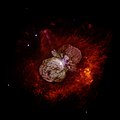Файл:Eta Carinae.jpg
Внешний вид

Къаддæргонды ас: 600 × 599 пикселы Другие разрешения: 240 × 240 пикселы | 480 × 480 пикселы | 769 × 768 пикселы | 1025 × 1024 пикселы | 2015 × 2013 пикселы.
Оригиналы файл (2015 × 2013 пикселы, файлы уæз: 163 КБ, MIME тип: image/jpeg)
Файлы истори
Ныххæц датæ/рæстæг-ыл, цæмæй фенай еуæд куыд фæзындис.
| Датæ/рæстæг | Къаддæргонд | Барæнтæ | Архайæг | Фиппаинаг | |
|---|---|---|---|---|---|
| нырыккон | 09:41, 18 декабры 2017 |  | 2015 × 2013 (163 КБ) | The NMI User | Reverted to version as of 14:14, 1 May 2008 (UTC) |
| 14:45, 13 мартъийы 2017 |  | 3000 × 2998 (1,18 МБ) | Leogorgon | larger file size | |
| 14:14, 1 майы 2008 |  | 2015 × 2013 (163 КБ) | Vol de nuit | {{Information |Description=(NASA News Release) A huge, billowing pair of gas and dust clouds are captured in this stunning NASA Hubble Space Telescope image of the supermassive star Eta Carinae. Using a combination of image processing techniques (ditheri |
Файлæй архайд
Ацы файлæй иу фарс дæр пайда нæ кæны.
Ацы файлæй куыд пайда кæнынц
Данный файл используется в следующих вики:
- Использование в da.wikipedia.org
- Использование в en.wikipedia.org
- Star
- Eta Carinae
- Wikipedia:Selected anniversaries/March 11
- Wikipedia:Today's featured article/March 2017
- Wikipedia:WikiProject Wikipack Africa Content/Wikipedia:Showcase
- Wikipedia:WikiProject WikiFundi Content/Eta Carinae
- Wikipedia:Today's featured article/requests/Eta Carinae
- Wikipedia:Today's featured article/March 12, 2017
- Wikipedia:Main Page history/2017 March 12
- Wikipedia:WikiProject WikiFundi Content/Wikipedia:Showcase
- Wikipedia:Main Page history/2022 March 11
- Wikipedia:Main Page history/2022 March 11b
- Wikipedia:Main Page history/2023 March 11
- Wikipedia:Main Page history/2023 March 11b
- User:2003 LN6/sandbox/Eta Carinae variable
- List of luminous blue variable stars
- Использование в en.wikiversity.org
- User:Marshallsumter/Radiation astronomy2/Visuals
- User:Marshallsumter/Radiation astronomy2/Violets
- Stars/Astronomy
- User:Marshallsumter/Radiation astronomy2/Violets/Quiz
- Stars/Sun/Astronomy/Quiz
- User:Marshallsumter/Radiation astronomy/Courses/Principles/Hourly 2
- User:Marshallsumter/Radiation astronomy/Courses/Principles/Final quiz
- Draft:Original research/Io/Quiz
- Titan/Quiz
- Stars/Solar systems/Quiz
- Moon/Quiz
- Earth/Quiz
- User:Marshallsumter/Radiation astronomy/Colors/Quiz
- Volcanoes/Io/Quiz
- Stars/Violets
- User:Marshallsumter/Radiation astronomy2/Stars
- Stars/Violets/Quiz
- Использование в es.wikipedia.org
- Использование в fr.wikipedia.org
- Использование в hi.wikipedia.org
- Использование в it.wikibooks.org
- Использование в la.wikipedia.org
- Использование в mk.wikipedia.org
- Использование в ms.wikipedia.org
- Использование в my.wikipedia.org
- Использование в oc.wikipedia.org
- Использование в ru.wikipedia.org
- Использование в sk.wikipedia.org
- Использование в sr.wikipedia.org
- Использование в th.wikipedia.org
Просмотреть глобальное использование этого файла.

